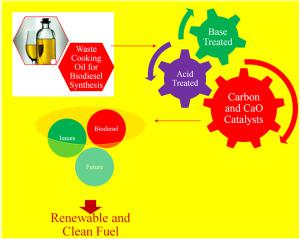Environmental Technology & Innovation ( IF 7.1 ) Pub Date : 2020-10-08 , DOI: 10.1016/j.eti.2020.101200 Muhammad Hamza , Muhammad Ayoub , Rashid Bin Shamsuddin , Ahmad Mukhtar , Sidra Saqib , Imtisal Zahid , Mariam Ameen , Sami Ullah , Abdullah G. Al-Sehemi , Muhammad Ibrahim

|
Biodiesel is produced through the process of transesterification of different edible and non- edible oils and animal fats. The process takes place either in the presence of a homogeneous or heterogeneous catalyst. A suitable catalyst is selected based on the amount of free fatty acid (FFA) content present in the oil. The major difference between homogeneous and heterogeneous catalysts is that the homogeneous catalysts are insensitive to the amount of free fatty acids present in the oil. Also, homogeneous catalysts are toxic, highly flammable, and corrosive. Besides, the use of homogeneous catalysts produces soaps as a by-product and a bulk of wastewater which requires additional pretreatment methods and expenses for proper disposal. The research on the biodiesel synthesis in the presence of heterogeneous catalysts (carbon-based catalysts) is continuously studied to achieve a suitable process to produce biodiesel and to improve fuel quality on an industrial scale. Heterogeneous catalysts have great significance in the biodiesel production because of their simple and less expensive manufacturing process, ease of separation, and high reusability. They can be prepared easily by functionalizing the carbon surface with acid or base. Carbon-based catalysts have a high surface area and porosity that can enhance the rate of the esterification/transesterification process. Also, solid acid catalysts can convert the low-quality feedstocks to biodiesel in the presence of active acidic sites. Besides, carbon-based catalysts can be produced through waste e.g. sugarcane bagasse and their use make the production of biodiesel “Greener” one. This review paper is mainly based on the utilization of different catalysts derived from waste biomass in the biodiesel. Under optimum conditions biodiesel (FAME) yields 90%–99% were reported in the literature.
中文翻译:

废生物质衍生的生物柴油生产催化剂综述
生物柴油是通过不同食用油和非食用油以及动物脂肪的酯交换过程生产的。该方法在均相或非均相催化剂的存在下进行。基于油中存在的游离脂肪酸(FFA)含量选择合适的催化剂。均相和非均相催化剂之间的主要区别是均相催化剂对油中存在的游离脂肪酸的量不敏感。同样,均相催化剂是有毒的,高度易燃的和腐蚀性的。此外,使用均相催化剂会产生肥皂作为副产品和大量废水,这需要额外的预处理方法和适当处置的费用。在多相催化剂(碳基催化剂)存在下对生物柴油合成的研究不断进行,以实现一种合适的生产生物柴油的方法并在工业规模上改善燃料质量。非均相催化剂在生物柴油生产中具有重要意义,因为它们的制造过程简单且成本较低,易于分离且可重复使用性很高。通过用酸或碱官能化碳表面,可以轻松制备它们。碳基催化剂具有高的表面积和孔隙率,可以提高酯化/酯交换过程的速度。同样,固体酸催化剂可以在存在酸性活性位的情况下将劣质原料转化为生物柴油。此外,碳基催化剂可以通过废物产生,例如 甘蔗渣及其用途使生物柴油的生产“更绿色”。这篇综述论文主要基于生物柴油中废弃生物质衍生的不同催化剂的利用。在最佳条件下,文献报道了生物柴油(FAME)的产率为90%–99%。


























 京公网安备 11010802027423号
京公网安备 11010802027423号